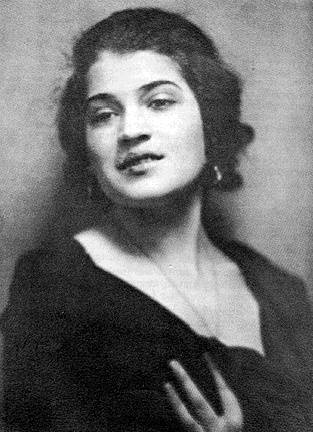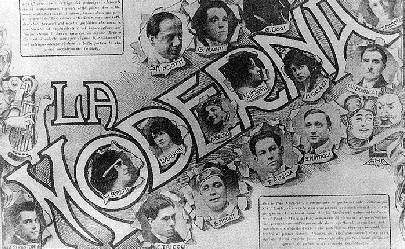Tina Modotti
Tina Modotti
Photo: San Francisco History Room, San Francisco Public Library
La Moderna advertisement
Image: San Francisco History Room, San Francisco Public Library
Tina Modotti was born on August 17, 1896 in Udine, a small town in northern Italy. Her father, Guiseppe Modotti, was a machinist by trade and a socialist/trade unionist who struggled to support the growing Modotti family during a time of economic hard times in Italy and nearby Austria. Before Tina was ten, Guiseppe left Italy for America with plans to earn enough money to send for his wife and children. He settled in the bustling Italian sector of San Francisco. His departure plunged the family deeper into poverty and Tina and her older sister Mercedes began working in the nearby silk factory to help support the family. When she was 14, her older sister Mercedes joined her father in San Francisco and Tina became the only adult wage earner in the family. The suffering and hunger of her four younger brothers and sisters deeply affected her view of the world and the importance of the struggles of working people.
In 1913, the year of greatest Italian immigration to the United States, Tina joined her father and sister in San Francisco. At seventeen she travelled alone on a two week voyage across the Atlantic to New York, and then on the long train journey across the United States to Oakland and then finally by ferry to San Francisco. Her father Guiseppe and her sister Mercedes welcomed her at the North Beach dock when she arrived. Her new home was a first floor two bedroom flat at 1952 Taylor Street on the north east slope of Russian Hill, considered one of the better parts of town. Their bay window caught a tiny glimpse of the bay.
Guiseppe had opened a photography studio in Little Italy when he first arrived and Americanized his name to Joseph. But that shop closed after a year and by the time Tina arrived he had his own machinist workshop on Montgomery Avenue, where he later designed a popular ravioli machine. Mercedes worked as a seamstress at I Magnin which advertised itself as importers, manufacturers and retailers of ladies', childrens' and infants' wear. Tina joined her in the sweatshop. But Tina and her family enjoyed their free time to the fullest in the surrounding countryside and in Little Italy itself. In 1913 organizations like the IWW attracted many immigrants who brought with them a tradition of union activism. There was also a very popular Italian theater revival, with the Washington Square theater only two blocks from the Modotti's home.
In 1914 the opening of the Stockton Tunnel linked Little Italy to the center of San Francisco. Tina's beautiful face and perfect figure captured the attention of her employers and she began to model I Magnin's newest designs at their downtown store. As 1915 approached all of San Francisco was occupied by the upcoming Panama-Pacific Exposition. This marked a turning point in Tina's life. The 18 year old Tina was drawn to the Palace of Fine Arts where an international exhibit of Modern Art and Photography was called more than a gathering together of great paintings and sculptures. It was a school . At this exhibit she met the young painter and poet Roubaix de l'Abrie Richey. Known as Robo, he was tall and handsome, dressed in cape and a cane, the epitome of the bohemian artist. The two young people met each other unexpectedly in the Palace of Fine Arts and their common ideals and admiration for art was transformed into mutual love. (L'Italia)
By 1916 Tina was auditioning for parts in the amateur theater clubs that existed in the area. By 1917 she landed a part in the light opera company Citta di Firenze, under the direction of Alfredo Aratoli. By September she was being featured by the company and reviewed in the local Italian newspaper L'Italia: "Tina Modotti, the pretty signorina we have so often admired and applauded in the small amateur theatres of the city made her debut .The years will pass, and the times will change, but the performance of yesterday evening will always leave in her all of that freshness of a soul in love with her art ." Soon after her professional debut World War I was ravaging Italy. Tina got involved in supporting humanitarian aid for the refugees, among whom were her own family back in Italy. In a play to benefit Italian war victims, La Nemica, Tina surprised even her warmest admirers by the dramatic intensity with which she was able to invest her role, especially in the great final scene of the first act. (L'Italia)
Tina was a popular star in the Italian theater by 1918, and attracted the attention of Hollywood, when D.W. Griffith came to San Francisco looking for talent. Soon after, Tina married Robo in October, 1918 and moved to Hollywood, where she appeared in silent films. Both Tina and Robo became very involved in the Bohemian arts scene flourishing in and around Hollywood. There she met Edward Weston, who had become a friend of Robo's. Tina modelled for Weston and began to learn photography from him. Her husband Robo died of smallpox in Mexico in 1922 while Tina was enroute to join him there. Subsequently Tina and Weston moved to Mexico together and became part of the vibrant scene of political artists that included Diego Rivera and Frida Kahlo. Tina Modotti is probably most famous for her work as a photographer in Mexico, where she and Weston lived for many years.
--Mary Ellen Churchill


